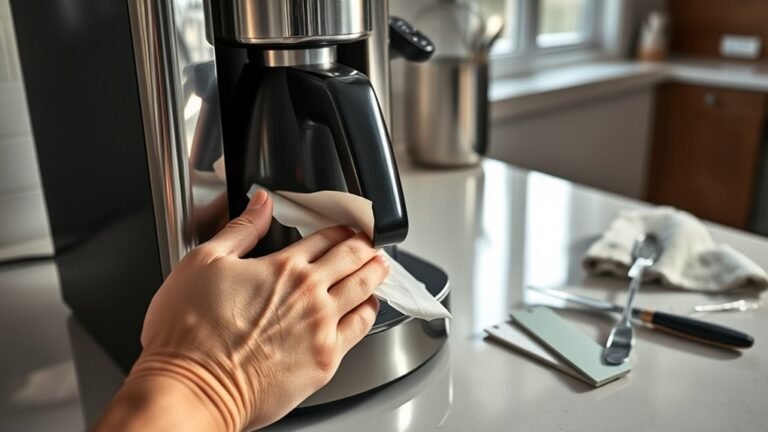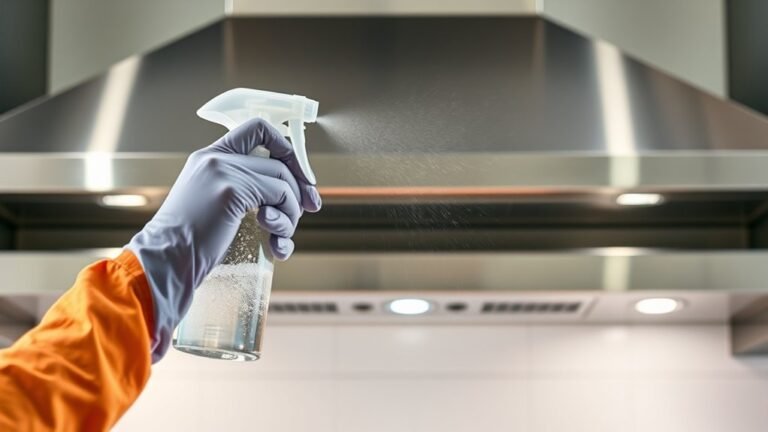Removing Germs Stains From Dryer
To remove germ stains from your dryer, start by unplugging it and cleaning the lint trap and drum thoroughly to eliminate moisture and debris that breed bacteria and mold. Use a disinfectant like hydrogen peroxide or white vinegar on the drum surfaces and seals, avoiding harsh chemicals. Regularly airing out the dryer and running at high heat helps prevent mold growth. Following these steps guarantees hygiene and efficiency—explore further for detailed cleaning procedures and long-term prevention tips.
Understanding the Causes of Germ Stains in Dryers

Although dryers are designed to remove moisture and sanitize clothing, germ stains can still develop inside them due to residual moisture, lint buildup, and the presence of bacteria or mold. Your drying habits play an essential role in minimizing moisture retention, which is the primary factor allowing microbial growth. For example, overloading the dryer or using low heat settings can leave damp areas, encouraging bacteria to thrive. Additionally, lint accumulation traps moisture and provides a breeding ground for germs. To maintain freedom from germ stains, focus on optimizing drying cycles and regularly cleaning lint filters and drum interiors. Understanding these causes empowers you to implement effective preventive measures, ensuring your dryer remains hygienic and efficient without compromising your lifestyle.
Identifying Common Germ Stains and Odors
When you notice unusual discolorations or persistent odors inside your dryer, these are often signs of germ stains caused by bacteria, mold, or mildew growth. For effective stain identification, focus on areas with visible dark spots, greenish patches, or slimy residues, especially near the drum seals and lint traps. Odor detection is equally significant; musty or sour smells typically indicate microbial presence. Pay close attention to any damp or poorly ventilated spots, as these conditions promote germ proliferation. By accurately identifying these common germ stains and odors, you can target your cleaning efforts precisely, ensuring thorough removal. This approach helps maintain your dryer’s efficiency and safeguards your laundry from contamination, granting you the freedom to rely confidently on your appliance’s cleanliness.
Preparing Your Dryer for Cleaning

Before you begin cleaning your dryer, make sure it’s completely unplugged and cooled down to prevent any electrical hazards or burns. Next, gather essential cleaning supplies such as a vacuum with a brush attachment, microfiber cloths, mild detergent, and a soft brush. Remove the lint trap and clear out all lint residues thoroughly to improve dryer maintenance and airflow. Detach the lint filter screen and soak it in warm, soapy water to loosen stubborn debris. Also, inspect the dryer vent and hose for blockages, as these can harbor germs and affect efficiency. Make certain you have a well-ventilated workspace to avoid inhaling dust or cleaning agents. Proper preparation not only enhances your cleaning effectiveness but also extends your dryer’s lifespan, granting you the freedom of reliable, hygienic operation.
Effective Cleaning Solutions for Germ Removal
Since germ stains can embed deeply within your dryer’s surfaces, selecting the right cleaning solutions is essential for effective removal. You want germ fighting solutions that are both potent and safe, ideally eco friendly cleaners that protect your health and environment. Here’s a quick comparison of effective options:
| Cleaner Type | Germ Killing Efficiency | Eco Friendliness |
|---|---|---|
| Hydrogen Peroxide | High | Yes |
| White Vinegar | Moderate | Yes |
| Commercial Disinfectants | Very High | Usually No |
| Baking Soda Paste | Moderate | Yes |
Choose solutions that balance efficacy with eco friendliness, ensuring you maintain freedom from harsh chemicals while thoroughly removing germs and stains.
Step-by-Step Guide to Cleaning the Dryer Drum

Cleaning the dryer drum thoroughly requires following a clear sequence of steps to confirm all germ stains and residues are removed effectively. First, unplug the dryer to confirm safety. Use a microfiber cloth dampened with a mixture of equal parts white vinegar and water to wipe the drum’s interior, focusing on visible stains. For stubborn residues, apply a small amount of baking soda paste, scrub gently, then wipe clean. Allow the drum to air dry completely before use. Incorporate these dryer maintenance tips regularly to prevent germ buildup. Consistent cleaning supports effective germ prevention strategies, reducing contamination risks and extending your dryer’s lifespan. By maintaining a pristine drum environment, you confirm your laundry routine remains hygienic and efficient, granting you the freedom to trust your appliances fully.
How to Clean and Sanitize the Lint Trap
Maintaining a clean dryer drum sets the stage for addressing other key components like the lint trap, where lint and debris accumulate rapidly. For effective lint trap maintenance, start by removing visible lint after each load to prevent buildup. Next, use a soft brush or vacuum attachment to clear finer particles lodged deep within the screen. To sanitize the lint trap, wipe it down with a cloth dampened in a 70% isopropyl alcohol solution; this kills germs without leaving residue. Allow it to air dry completely before reinserting. Regularly applying these sanitizing techniques reduces microbial presence and enhances dryer efficiency, ensuring your laundry environment stays hygienic. Following this precise routine offers you the freedom to maintain peak dryer performance safely and effectively.
Tips for Preventing Germ Buildup in Your Dryer
Although dryers operate at high temperatures, germs can still accumulate in hidden areas if not properly managed. To guarantee effective germ prevention, you must focus on consistent dryer maintenance. Regularly cleaning the drum, vent, and seals reduces microbial buildup and improves airflow. Avoid overloading your dryer to allow thorough drying, which inhibits germ proliferation.
| Task | Frequency | Nutzen |
|---|---|---|
| Clean lint trap | After every use | Removes debris, reduces germs |
| Inspect vent ducts | Quarterly | Prevents moisture buildup |
| Wipe drum & seals | Monthly | Eliminates residue |
| Use dryer sheets | Every cycle | Minimizes static and microbes |
| Dry at high heat | Each load | Kills most bacteria |
Implement these steps for ideal germ prevention and a hygienic drying environment.
When to Use Professional Dryer Cleaning Services
If you notice persistent odors, visible mold, or residue that resists regular cleaning, it’s time to evaluate professional dryer cleaning services. Experts use specialized equipment to eliminate deep contamination that standard methods can’t reach. This guarantees thorough germ removal, improving both hygiene and dryer efficiency.
Signs of Deep Contamination
Persistent odors, visible mold, and repeated lint buildup are clear signs that your dryer may be deeply contaminated beyond routine cleaning. These contamination signs indicate that germs and allergens have embedded within hard-to-reach areas, requiring professional intervention. Germ identification through specialized tools confirms the extent of microbial presence, guiding effective remediation.
| Contamination Sign | Implication |
|---|---|
| Persistent Odor | Microbial growth inside ducts |
| Visible Mold | Structural contamination |
| Repeated Lint Buildup | Blocked airflow, fire hazard |
| Poor Drying Efficiency | Residue affecting heating |
| Excess Moisture | Risk of germ proliferation |
If you notice multiple signs, professional dryer cleaning services become essential to restore safety and freedom from hidden contaminants.
Benefits of Expert Cleaning
When your dryer shows signs of deep contamination, relying on professional cleaning services guarantees thorough removal of germs and allergens that routine maintenance can’t address. Experts use specialized equipment and expert techniques to access hard-to-reach areas, ensuring a complete cleanse that prevents microbial buildup. This level of cleaning not only restores your dryer’s efficiency but also provides significant health benefits by eliminating harmful pathogens that standard cleaning misses. You’ll reduce allergy risks and improve indoor air quality, creating a safer environment for you and your family. Opting for professional service at the right time frees you from guesswork and the hassle of ineffective DIY methods. With expert intervention, you regain confidence in your dryer’s cleanliness and operational safety, supporting your desire for a healthy, worry-free home.
Maintaining a Germ-Free Dryer for Long-Term Use
To maintain a germ-free dryer long-term, you should establish a regular cleaning routine targeting lint traps and drum surfaces. Incorporate disinfectants approved for appliance use to eliminate residual bacteria effectively. Additionally, controlling moisture levels inside the dryer will prevent mold growth and guarantee peak hygiene.
Regular Cleaning Routine
Although occasional deep cleaning is essential, establishing a regular cleaning routine guarantees your dryer remains germ-free and operates efficiently over time. Implementing a consistent cleaning schedule focused on lint traps, drum surfaces, and moisture sensors prevents buildup that fosters germs and reduces performance. Regular maintenance involves wiping the interior with a damp microfiber cloth and vacuuming vents monthly to eliminate hidden contaminants. By adhering to this schedule, you minimize the risk of mold and bacteria accumulation, ensuring hygienic drying cycles. Document your cleaning activities to track adherence and identify when more intensive interventions are needed. This systematic approach not only preserves your dryer’s longevity but also protects your laundry from cross-contamination. Prioritize this disciplined routine to maintain a germ-free environment and enjoy unrestricted use without health concerns.
Use of Disinfectants
Since regular cleaning alone might not eliminate all germs, incorporating disinfectants into your dryer maintenance routine is crucial for long-term hygiene. Choose disinfectant types that are effective against bacteria and viruses but safe for appliance surfaces, such as alcohol-based sprays or diluted bleach solutions. Apply disinfectants after each cleaning cycle or at a cleaning frequency aligned with heavy use, typically once every two weeks. Confirm the dryer is unplugged before application, and allow the disinfectant to air dry completely to maximize germicidal action. Avoid harsh chemicals that may degrade dryer materials or leave harmful residues. By integrating appropriate disinfectants systematically, you maintain a germ-free environment, prolonging your dryer’s efficiency and safeguarding your freedom from contamination in your laundry process.
Preventing Mold Growth
When you want to keep your dryer germ-free over the long term, preventing mold growth is essential. Mold thrives in environments with high dryer humidity and stagnant air. To effectively manage mold prevention, always leave the dryer door open after each use to allow moisture to escape and air to circulate. Regularly clean the lint trap and vent system to reduce moisture buildup. Use a moisture absorber or dehumidifier in the laundry area to maintain ideal dryer humidity levels below 50%. Inspect seals and gaskets for damage that could trap moisture. By controlling dryer humidity and ensuring proper ventilation, you eliminate the conditions mold needs to grow, ensuring your dryer remains hygienic and efficient, granting you the freedom from constant worry about contamination.
Häufig gestellte Fragen
Can Germ Stains Damage My Dryer’S Internal Components?
Think of germ growth as a slow, creeping vine inside your dryer. While these microbes themselves typically don’t directly damage your dryer’s internal components, they can lead to unpleasant odors and potential clogs in vents or filters. Neglecting appliance maintenance might let this buildup affect performance or cause overheating. Regular cleaning guarantees your dryer runs efficiently, giving you the freedom to rely on it without worry or unexpected breakdowns.
Are There Specific Detergents That Cause More Germ Stains?
You’ll find that certain detergent ingredients, like heavy fragrances or dyes, can sometimes contribute to residue buildup, which may attract germs, causing stains. Choosing antibacterial options with active agents like triclosan or benzalkonium chloride can help reduce microbial presence effectively. To maintain freedom from germ stains, look for detergents formulated with clear ingredient lists and proven antibacterial efficacy, ensuring thorough cleaning without compromising your dryer’s performance or your laundry’s freshness.
How Often Should Dryer Vents Be Professionally Cleaned?
Think of your dryer vents as arteries; if clogged, they can cause serious problems. For ideal dryer maintenance, you should schedule professional cleaning every 1 to 3 years, depending on usage. High-frequency use demands more regular cleaning. This cleaning frequency guarantees your dryer runs efficiently, prevents fire hazards, and extends its lifespan, giving you the freedom to enjoy hassle-free laundry without unexpected breakdowns or safety concerns.
Can Using Dryer Sheets Contribute to Germ Buildup?
You might wonder if dryer sheets contribute to germ buildup. Dryer sheet ingredients often include softening agents and fragrances, which can leave residues inside your dryer, potentially trapping germs over time. To prevent this, follow germ prevention tips like regularly cleaning your dryer drum and vent. Opt for natural or fragrance-free sheets to reduce residue. This approach helps maintain a cleaner, more hygienic dryer environment without sacrificing your laundry’s freshness.
Is It Safe to Use Bleach in a Dryer for Germ Removal?
You might wonder about bleach effectiveness and dryer safety when using bleach in a dryer for germ removal. Bleach can disinfect, but it’s not recommended to pour it directly into the dryer, as it can damage components and create harmful fumes. Instead, use it cautiously on washable parts or fabrics before drying. For germ removal, prioritize proper cleaning cycles and guarantee good ventilation, preserving both your freedom and your dryer’s longevity.






